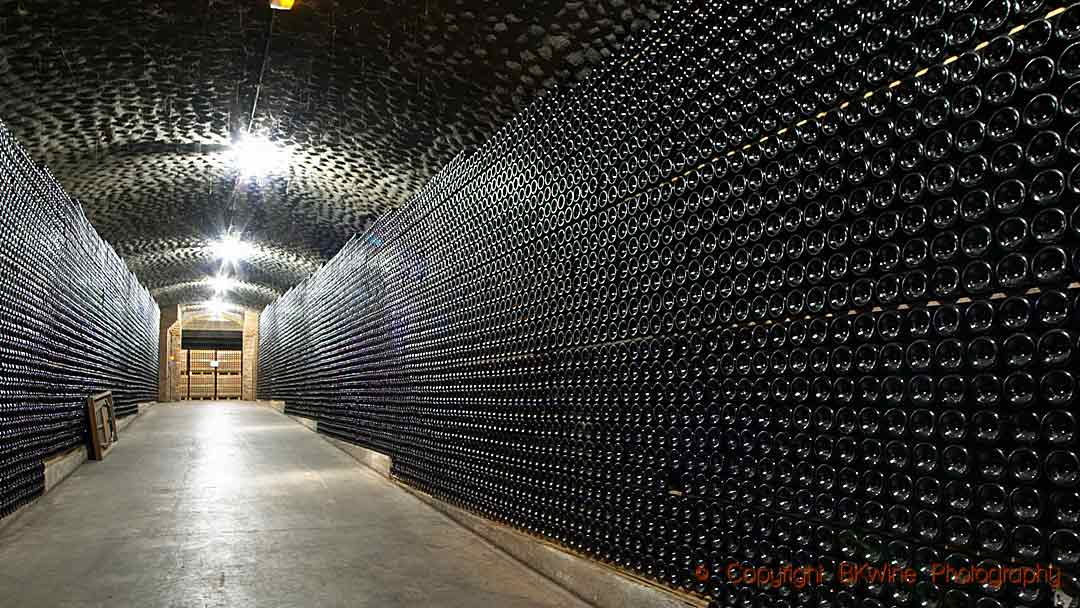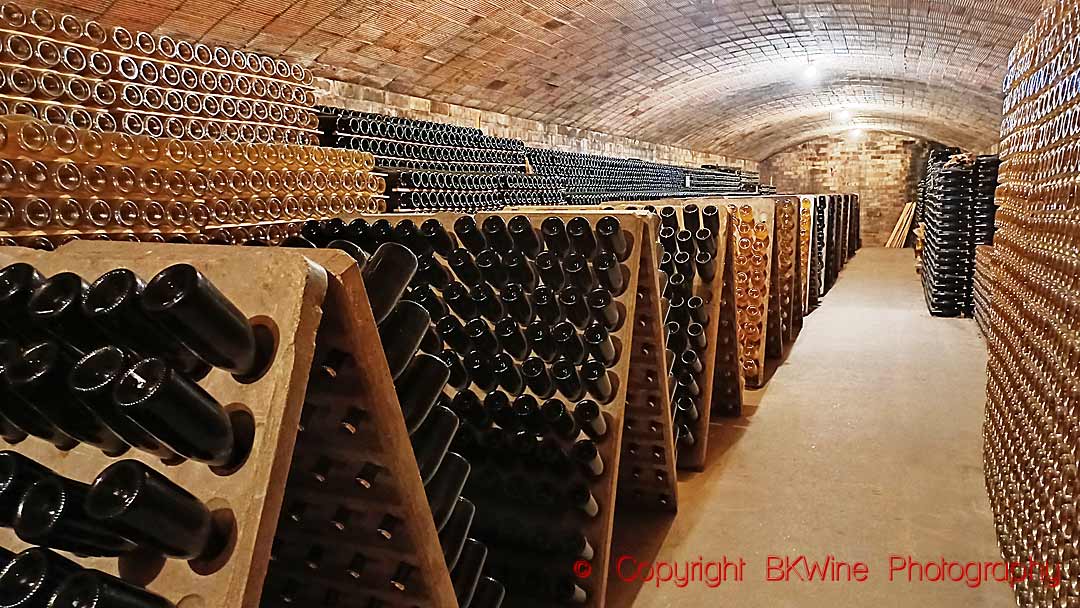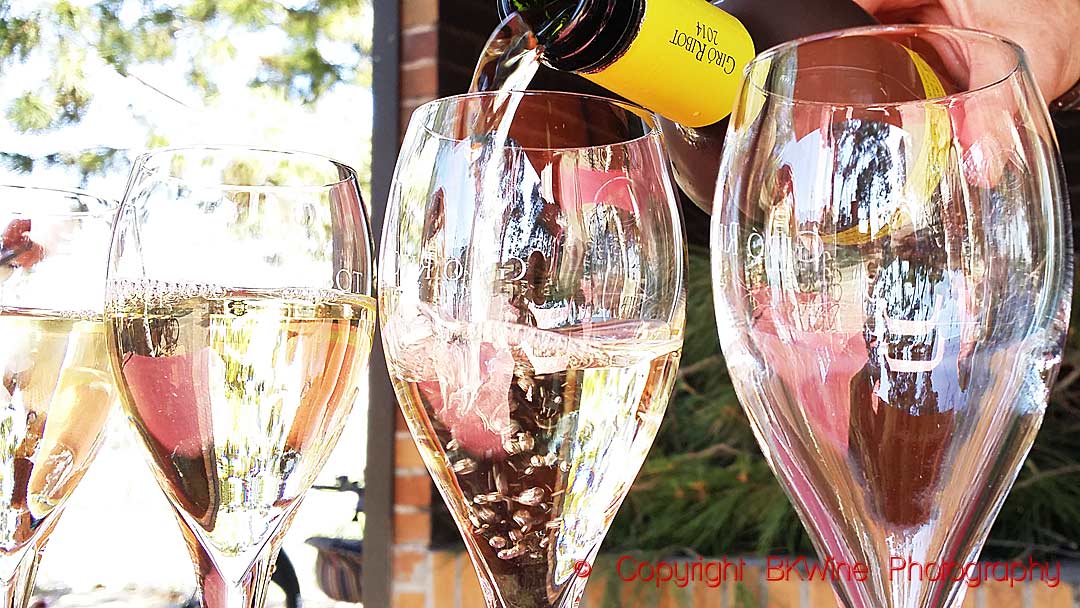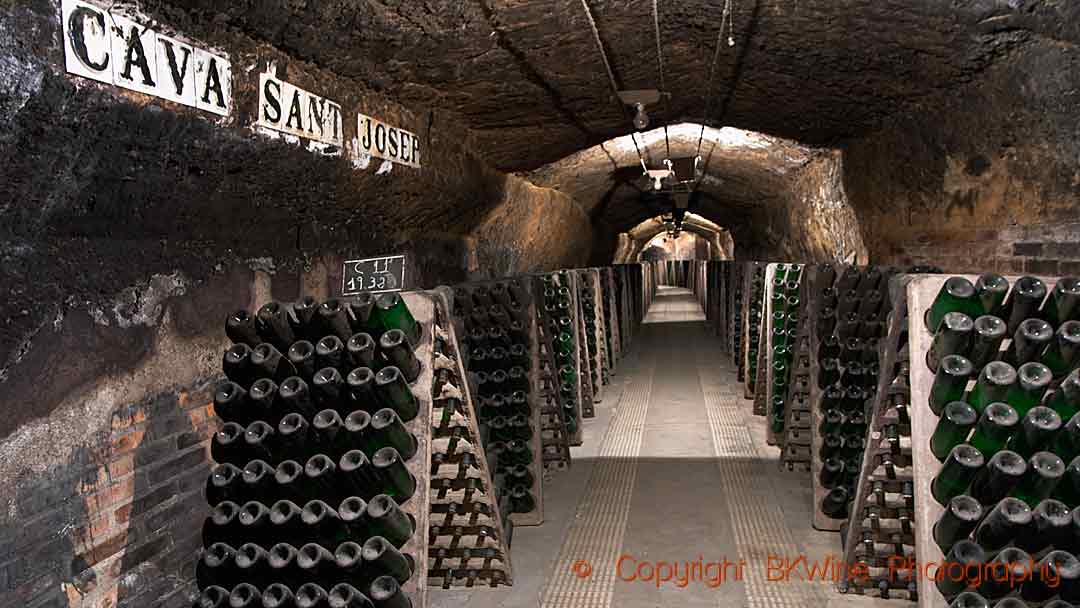The effervescent world of Cava produces 250 million bottles each year from 38,000 hectares of vineyards, not unlike Champagne, which makes around 300 million bottles from 34,000 hectares. But while champagne often basks in the glow of prestige and commands a steeper price, cava is affordable, and any enthusiast can enjoy its bubbly delights. However, cava is not only about affordability. The Cava producers want the world to know that they also make top-quality wines, as a recent tasting in Barcelona unequivocally showed.
This is a longer version of an article published on Forbes.com.
Quick facts on cava
- Cava is made with a second fermentation in bottle – the “traditional” method” – just like champagne, crémant, South African MCC, Franciacorta and many other quality sparkling wines
- Cava (denominacion de origen Cava) can be made in several Spanish wine regions but the vast majority comes from Catalonia. The small town San Sadurní d’Anoia has been called the Cava Capital
- 8 million bottles of cava were sold in 2023. 253.8 million bottles were produced.
- 68% of all cava is exported. The biggest markets are Germany, Belgium, USA, UK and Sweden
- 13% of cava is organic, 9% is rosé
- The registered surface area of cava is 38,000 hectares
- The three main grape varieties are macabeo (37%), xarel-lo (26%), and parellada (19%). In addition there are also chardonnay, garnacha tinta, trepat, pinot noir, subirat parent and monastrell (together 18%).
- There are four categories of cava: Cava de guarda (minimum 9 months ageing), cava de guarda superior reserva (18 months), cava de guarda superior gran reserva (30 months), and cava de guarda superior paraje calificado (36 months)
Cava also carry the same sweetness/dryness designation as other sparkling wines in the EU: brut (and extra brut, brut nature), extra dry, dry etc (sometimes in Spanish) with the same limits. Read more here: Sugar levels in champagne and other sparkling wines
Although many consumers only know the entry level cava, often from the big houses, most cava producers, large and small, have both a cheaper and a more upscale segment (although some focus on one segment or the other). As always, when it comes to large wine regions, there is a bit of everything in cava country, and as a consumer, you choose according to your wallet, occasion, and mood. It almost always pays to opt out of the cheapest if you want a bit of character in your wine. This also applies to cava.
Over the past few years, Cava has been on a mission to establish its own identity in the competitive world of sparkling wines. The focus is on highlighting the Spanish essence of Cava and introducing consumers to high-quality Cava. The term Cavas de Paraje Calificado, introduced in 2017, epitomises this endeavour. It represents a Cava from a specific vineyard, carefully chosen for its location and terroir. The winery must not only own but also meticulously maintain its ‘paraje’, and the quality of the vineyard is verified through rigorous soil analyses.
A Cava de Paraje Calificado must be aged on the lees for at least 36 months. The harvest yield must not exceed 48 hectolitres per hectare, which is quite low for sparkling wines. The harvest must be manual (some cava is harvested by machine, which is facilitated by the fact that the three main grapes are white, unlike in Champagne, where two are red that makes hand-harvesting more important). In a cava de paraje calificado, the three local grapes macabeo, xarel·lo and parellada as well as pinot noir and chardonnay are permitted.
Xarel-lo is the grape that many associate with cava. It is native to the Penedès and is relatively easy to grow and thrives in different soils. It is mostly used for sparkling wines but also produces excellent still wines. It often produces characterful wines with good body, crispness, and acidity. It tolerates heat well and several cava producers I have spoken to believe that xarel-lo is the best grape in the region to cope with an increasingly hot and dry climate.
Macabeo is the most planted grape for cava. It is found in other places in Spain; in Rioja it goes by the name viura. But it originally comes from Penedès, more precisely from the village of Vilafranca. Macabeo is a robust and hardy grape. It ripens late and generally produces balanced and light, floral wines with medium acidity.
Parellada gives the wine finesse, freshness, a light aromatic character and often a distinct fruit and good acidity. It has a good ageing potential. It buds early but ripens late. Parellada is well adapted to the Penedès vineyards at higher altitudes.
By introducing the concept of Cava de Paraje Calificado, the region also wants to show the complexity that can be achieved with extended ageing. During the Cava Meeting in Barcelona at the end of November last year, I took part in a tasting of extraordinary cavas. The tasting showed some of the “paraje calificado” (although most were older than 2017, when the term was formally introduced, so legally speaking, not strictly so) as well as cavas with long and sometimes very long ageing. It was, as you can imagine, a very enjoyable tasting featuring cavas from some of the top producers.
Top Cava Tasting
Cava Pere Ventura Gran Vintage Paratge Calificat Can Bas 2015
The grapes are xarel·lo and macabeo, and the vines are very old, between 60 and 105 years. The Can Bas vineyard is on four hectares and surrounded by water and forest. It is cultivated organically, with low yields, 3,500 kg per hectare, and with minimum intervention in the cellar. The fermentation is with wild yeast. This is a full-bodied and creamy cava style with a lovely, fresh, and mouthwatering acidity and a taste of almonds, citrus and fruit ripeness. Elegant and complex is the overall impression.
Cava Alta Alella Mirgin Exeo Paraje Calificado Vallcirera 2017
The producer Alta Alella is in the opposite direction from Barcelona compared to most other cava producers. It is situated just 20 minutes’ drive from Barcelona, north along the coast, and just two kilometres from the sea. Even the narrow, long shape of the bottle—the traditional bottle here—differs from other cava. According to the owner family Pujol-Busquets, the saltiness of the sea leaves its mark on the wines.
The base wine is aged in French oak for three months before bottling. The grapes are 60% xarel·lo and 40% chardonnay. “Pinot noir and chardonnay make excellent cava, but we must be in tune with the market. It is now trendy with local grapes,” says Mireia Pujol-Busquets. The wine has an excellent taste of orange peel, ripe stone fruit, and saltiness (yes, it is definitely there). It is fresh and dry with a lovely creamy mouthfeel; delicious
Cava Codorníu Ars Collecta Paraje El Trous Nou 2010
From a small winery within the big house of Codorníu. This is a 100% pinot noir from a vineyard with a cool location. The wine was disgorged in 2014. An exciting wine with aromas of ripe citrus and an unusually high acidity of 9 grams per litre. The dosage of 9 grams of sugar balances the wine, but it still has a crispness and steeliness that is quite remarkable. Very enjoyable.
Cava Codorníu Ars Collecta Paraje La Pleta 2013
This is a 100% chardonnay, and here, too, the acidity is high and fresh. It is tightly structured, with aromas of green apples and lemon. However, hints of maturity have begun to show.
Cava Vins El Cep, Claror Paratje Qualificat Can Prats 2015
This light and elegant cava has aromas of white flowers, almonds, green apples, and a slight saltiness. It feels fresh and energetic, with character. The vineyard is in the northernmost part of Penedès.
Cava Juvé & Camps La Capella 2009 Brut Nature, Cava de Paraje Calificado
La Capella is a 7-hectare vineyard with well-drained clay and limestone soil, with southern exposure. Around the vineyard are olive trees and pine forests. The grape is 100% xarel·lo, the vines are old and pruned as gobelet. “We want to show the ageing of xarel·lo”, says Meritxell Juvé, CEO and 4th generation of Juvé & Camps. And the grape does age splendidly. This is a fabulous cava with a mature, slightly burnt character, and is very expressive. There is a bit of honey caramel which softens the brut nature style. Delicious.
Cava Vins Familia Ferrer, José Ferrer Can Sala 2013
The Ferrer family founded Freixenet in 1914. Nowadays, the house is in the hands of Henkell in Germany. Familia Ferrer Can Sala, however, is still owned and run by the family. Here, we have 75% xarel·lo and 25% parellada, “but since then, we have switched to 50/50”, says CEO José Ferrer. It is full-bodied, quite intense, has a lovely mouthfeel, and is dry and fresh in the finish. The ripe aromas stay long on the palate.
Cava Vins Familia Ferrer Paraje Calificado Can Sala 2008
Very savoury with ripe yellow fruit, citrus, and nuts. Great complexity and flavours that linger for a long time.
Cava Vins Familia Ferrer, Vinyes de Can Sala 2015
100% parellada, which is unusual. It is pleasant, still young and energetic, complex with layers of flavours. Hints of ripe fruit, elegant with a crisp, fresh finish.
Cava Agustí Torelló Mata Kripta Gran Reserva 2011
This is a superb, exciting, and refreshing cava, with peach and honey on the nose and evolved toasty aromas of brioche on the palate with a bit of bitter almond in the aftertaste.
Cava Mestres Mas Via Gran Reserva Extra Brut 2003
Mestres is one of the oldest cava houses. The house only makes the higher category Cava de Guarda Superior Gran Reserva. Two of Mestres’ hallmarks are the ageing of the base wine in oak barrels and extended ageing on the lees. Right now, they are selling vintage 2006.
In 1945, Josep Mestres made his first sparkling wine without adding sugar, thus one of the first brut nature in history. His son, Antonio Mestres, now takes care of the business. He is, he says, a bit obsessed with gastronomic wines. He always thinks about gastronomy, so he has, of course, a significant focus on making cava that goes well with food.
This Gran Reserva 2003 was disgorged in 2018. It is an exceptional wine in an oxidative style. Dark in colour, it has a huge nose of honey, roasted coffee, and walnuts. It is a beautiful wine and very different from a young cava. Grapes are 75% xarel·lo and the rest macabeo and parellada.
Cava Blancher, Carbá Capdevila Reserva 1975
The oldest cava we tasted was made before Cava DOC even existed. The bubbles are slightly tired, but you can easily forgive that, as this is a magnificent wine. The colour is beautiful amber, and the aroma is reminiscent of honey, walnuts, baked apples, and coffee—a treat.
Travel
The best place to discover the true soul of cava is in Catalonia. Explore cava and other Catalonian wines on a wine tour to Spain with BKWine.
Travel to the world’s wine regions with the wine experts and the wine travel specialist.
Wine tours that give you insight. BKWine wine tours.






















